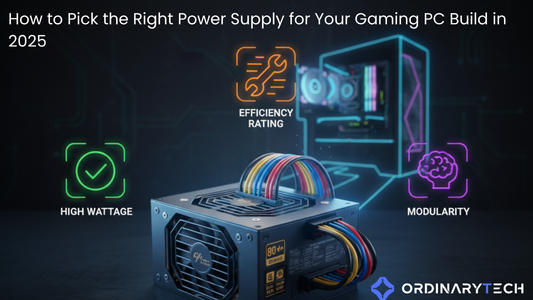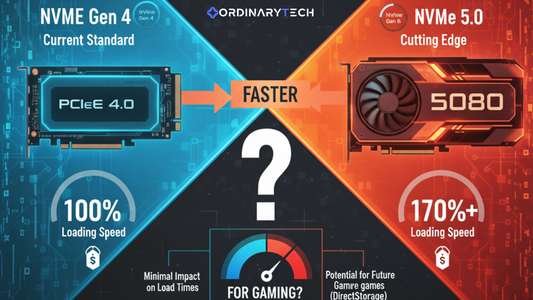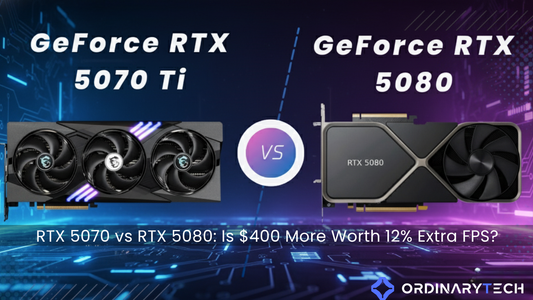
GPT-5 vs GPT-4: Smarter, Faster, or Just Flashier?
Sadip RahmanShare
GPT-5: Smarter AI, Faster Workflows: What It Means for High-Performance Systems
GPT-5 is not just the next version of GPT-4, it represents a new tier of AI capability. In recent 2025 benchmarks, it has set new highs for problem-solving in areas such as complex math, code generation, and multimodal understanding. But numbers only tell part of the story. For engineers, researchers, creatives, and gamers, the real question is: how does GPT-5 change what you can do on your workstation or gaming rig?
Why GPT-5 Changes the Hardware Conversation
On paper, GPT-5 solves problems with greater accuracy and in fewer tokens, often cutting output size by as much as 80% compared to earlier models. In practice, this means faster responses with less overhead. For professionals running complex AI-assisted workflows, like a developer debugging a large codebase or a researcher processing large datasets, this efficiency translates into less waiting and more doing.
It also retains context across sessions. In a real-world setting, that could mean a product design session that spans multiple days without having to reload instructions or parameters. This is a big step forward from one-off prompts, allowing AI to act more like a project partner than a query tool.
Pro Tip: If you’re routinely working with multimodal AI (text, image, video, and code), make sure your GPU and system memory are balanced for both generative tasks and real-time rendering. We are always configuring systems specifically for AI models like GPT-4,5. avoiding bottlenecks that cheaper builds often overlook.
Impact on Creative and Gaming Workflows
In fields like 3D art, film editing, and level design, GPT-5’s enhanced spatial reasoning can interpret and refine complex visual layouts. One of our clients had early beta access based in Toronto and used it to iterate On Unreal Engine map layouts. GPT-5 read the geometry, proposed changes, and generated supporting scripts, all within hours instead of days.
For gamers, the advantage isn't that GPT-5 plays the game for you - it’s that it can analyze strategies, adapt to image or map inputs on the fly, or even help design mods and overlays by generating both concept art and working code. All of that benefits from a high-end GPU and fast storage that can keep AI workflows seamless alongside actual gameplay.
The Cost-Efficiency Advantage
OpenAI’s pricing improvements for GPT-5 make it viable for heavier integrations. With input costs about half of GPT-4o, businesses that previously rationed AI usage can now deploy it more widely - whether that’s running internal coding assistants 24/7 or offering AI-driven customer tools without skyrocketing bills.
FAQs
Do I need to upgrade my PC to use GPT-5 effectively?
If you’re only running the models on your local hardware. However, for integrating GPT-5 into heavier local workflows - like running large datasets, training smaller local models alongside API calls, or working with AI-driven video pipelines, a well-equipped workstation with higher VRAM will prevent bottlenecks.
Is GPT-5 useful for game development?
Yes. Its improved multimodal reasoning makes it adept at generating game assets, code snippets, procedural designs, and gameplay analysis. The right hardware ensures these processes run quickly without interrupting builds or testing sessions.
How does OrdinaryTech support GPT-5 workflows?
We design and build custom PCs, AI-ready workstations, and GPU servers optimized for high-volume AI use. Whether you’re deploying GPT-5 into production tools or using it for creative pipelines, we tailor the system for your workload.
Ready to Harness GPT-5?
If GPT-5 marks the biggest AI leap since the introduction of transformer models, then your hardware is the runway for takeoff. Whether you’re a business integrating AI into daily operations or a gamer pushing the limits of design and play, system optimization is the missing piece.
Get a custom quote for an AI-optimized build, or browse workstation PCs built to handle GPT-5 and beyond.
Explore more at OrdinaryTech
Written by Sadip, Founder & Chief Architect at OrdinaryTech



